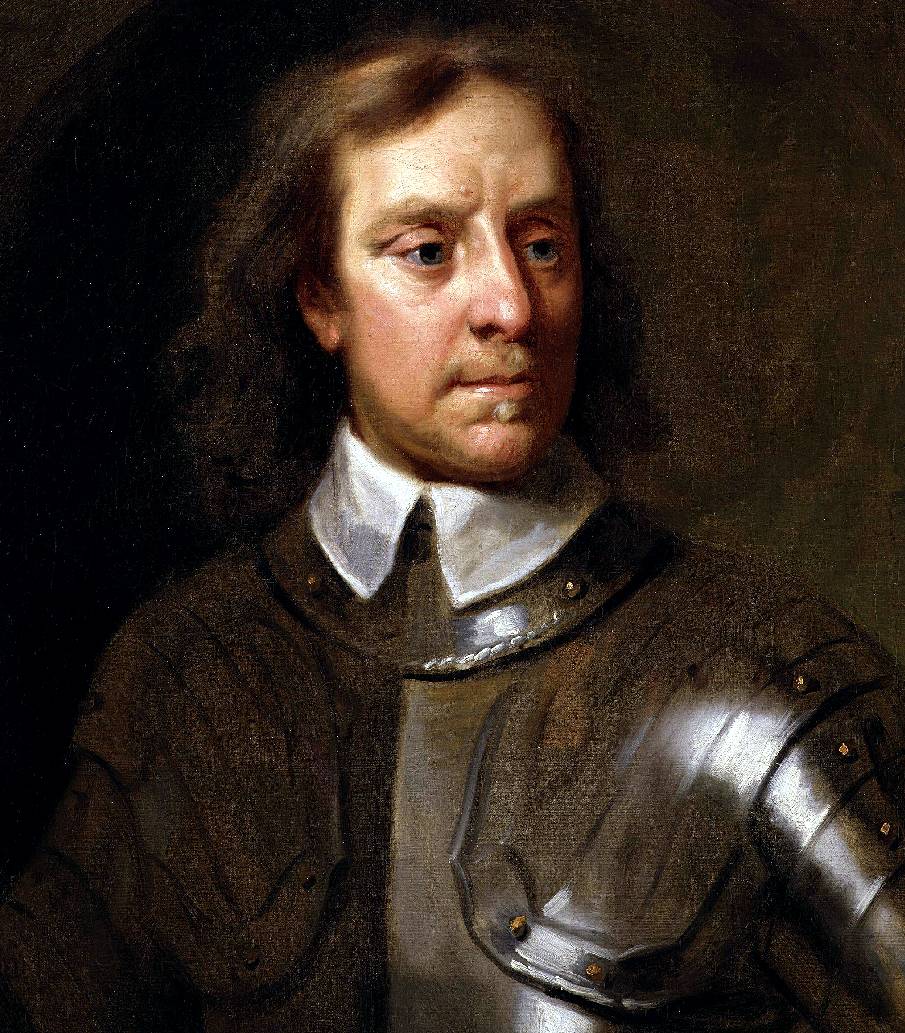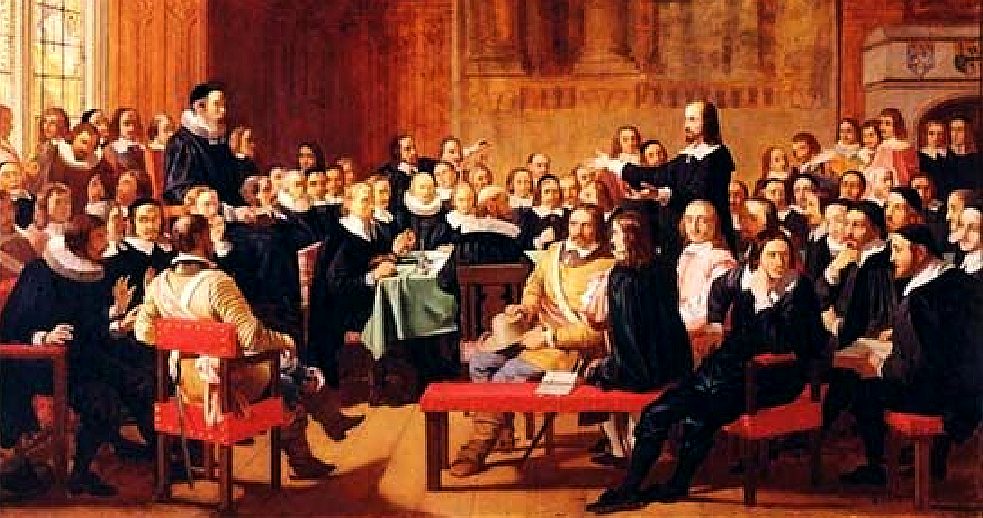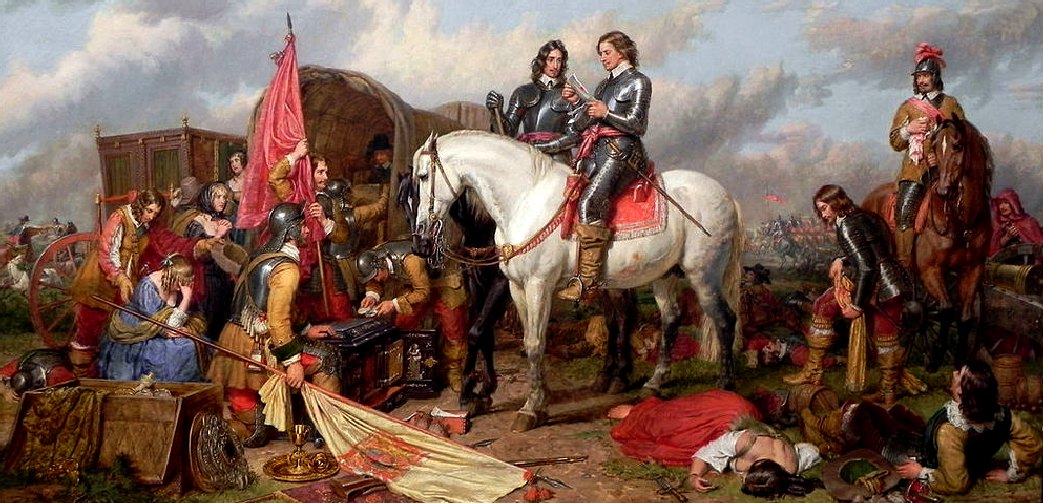|
PRIME MINISTERS OF THE UK
|
|
OLIVER CROMWELL - PARLIAMENTARIAN
As distinct from the Royal Family who once ruled Great Britain unfettered, Oliver Cromwell changed all of that when he lead the rebellion that was the English Civil War. Since then, the citizens of the United Kingdom have elected a leader via a democratic system of voting for candidates during what is called a General Election. The present system began in 1688 with the start of the process to remove decision making from King Charles I and II known as the English Civil War, with our first Prime Minister, Sir Robert Walpole, elected in 1721.
THE ENGLISH CIVIL WAR(S)
The English Civil War (16421651) was a series of armed conflicts and political machinations between Parliamentarians ("Roundheads") and Royalists ("Cavaliers") over, principally, the manner of England's government. The first (16421646) and second (16481649) wars pitted the supporters of King Charles I against the supporters of the Long Parliament, while the third (16491651) saw fighting between supporters of King Charles II and supporters of the Rump Parliament. The war ended with the Parliamentarian victory at the Battle of Worcester on 3 September 1651.
The overall outcome of the war was threefold: the trial and execution of Charles I (1649); the exile of his son, Charles II (1651); and the replacement of English monarchy with, at first, the Commonwealth of England (16491653) and then the Protectorate under the personal rule of Oliver Cromwell (16531658) and subsequently his son Richard (16581659). The monopoly of the Church of England on Christian worship in England ended with the victors' consolidating the established Protestant Ascendancy in Ireland. Constitutionally, the wars established the precedent that an English monarch cannot govern without Parliament's consent, although the idea of Parliament as the ruling power of England was only legally established as part of the Glorious Revolution in 1688.
THE GLORIOUS REVOLUTION
The Glorious Revolution, also called the Revolution of 1688, was the overthrow of King James II of England (James VII of Scotland) by a union of English Parliamentarians with the Dutch stadtholder William III, Prince of Orange. William's successful invasion of England with a Dutch fleet and army led to his ascension to the throne as William III of England jointly with his wife, Mary II, James's daughter, after the Declaration of Right, leading to the Bill of Rights 1689.
There is a gap of some 22 years before a the British public gained their first Prime Minister: Sir Robert Walpole.
ROUNDHEADS
v CAVALIERS - In the 1640s England was devastated by a civil war that divided the nation into two tribes Roundheads and Cavaliers. Counties, towns, even families and friends were rent apart as the nation pledged its allegiance either to King Charles I (supported by the Cavaliers) or to Parliament (backed by the Roundheads).
EDWARD THOMAS (fictional) HONEST JOHNSON LIZ TRUSS (shortest serving PM) BORIS JOHNSON (resigned in shame)
Sir Robert Walpole 1721 1742 Whig Party Boris Johnson 2019 - Tory Party
Interestingly, the average age at death of eighteenth-century Prime Ministers was just 64, of nineteenth-century premiers 74, and by the twentieth century this had risen to 81.
Four of the twentieth-century Prime Ministers (Winston Churchill, Harold Macmillan, Alec Douglas-Home and James Callaghan) made it into their 90s, but seven British Prime Ministers died in office. A further nine died within two-and-a-half years of leaving Number 10.
Overall, since the eighteenth century, the average age of all ex-Prime Ministers on leaving Number 10 was 61, the average age at death was 73: meaning that the average post-premiership or retirement has been 12 years long - if that is - they retired.
Since the eighteenth century one in four (14) Prime Ministers have come back to serve in later governments led by others. Some of these prime-ministerial retreads had had short tenures in Number 10. For example Douglas-Home who, after less than a year as PM, went on to serve as Foreign Secretary 1970-74; or the Duke of Wellington who, after two brief terms as PM, arguably exercised more influence as a senior party figure, Minister without Portfolio in Robert Peels government from 1841-46 and also as Commander-in-Chief of the Army from 1842 until his death in 1852. Arthur Balfour was PM for only three years but then went on to serve as a Cabinet minister for eleven years during and after the First World War and in the 1920s, under three different prime ministers.
Tony Blair immediately gave up his seat in the House of Commons on leaving Number 10 because of the alleged "war criminal" hoo-ha, but David Lloyd George stayed on in the Commons for a further twenty-two years and Edward Heath for twenty-seven years. The House of Lords has provided many others with a platform, enabling them to air their views and contribute to political debate. From the mid-nineteenth century until comparatively recently a hereditary earldom was the going rate for Prime Ministers who were not already peers. Macmillan was the last former Prime Minister to accept a hereditary earldom, in 1984, more than twenty years after leaving office. Douglas-Home was the first to go to the Lords with a life peerage, in 1974.
Meanwhile, from Sir Robert Walpole to Sir John Major, twenty-nine Prime Ministers or former Prime Ministers became Knights of the Garter Britains highest order of knighthood. Indeed, so far only nine Prime Ministers have ended their days as plain Mr, without accepting either a peerage or knighthood: Henry Pelham, George Grenville, William Pitt the Younger, Spencer Perceval, George Canning, William Gladstone, Andrew Bonar Law, Ramsay MacDonald, and Neville Chamberlain.
Historically, many former Prime Ministers were privately wealthy and able to retire to their country estates. Walpole amassed a large personal fortune in office. Lords Bute in the eighteenth century and Rosebery in the nineteenth were already among the wealthiest men in the country and married fabulously rich heiresses: when Rosebery died in 1929, he left £1.7 million the equivalent of nearly £60 million in todays money. But some former Prime Ministers had money troubles, both in and out of office. Both William Pitt the Elder (the Earl of Chatham) and his son, William Pitt the Younger, died leaving massive debts that were eventually paid off by Parliament with public funds. Some, such as Lords North and Melbourne, had money quietly loaned to them by the monarchs of the day. Herbert Henry Asquiths financial position was so bad that some of his friends organised an appeal for a fund to pay his debts and to give him a private pension for the last few years of his life.
Eventually pensions for former Prime Ministers were introduced in 1937 at the rate of £2,000 a year and then in 1972 the pension was linked to the previous prime-ministerial salary. This was initially set at 15/40ths then raised to half in 1991, following a recommendation from the Top Salaries Review Body. Former PMs also receive a special Public Duties Cost Allowance to help fund an office and secretarial support. Then in 2008 the Review Body proposed that former Prime Ministers should be part of the regular ministerial pension scheme, receiving three months severance pay and drawing a pension dependent on length of service and contributions.
The majority of former Prime Ministers in the last hundred years have put pen to paper and most (but not all) of those have written memoirs and autobiographies. But some twentieth-century former premiers wrote interesting non-political books, including Churchills history books, Heaths books about his wider interests in sailing, music and travel, Majors recent history of cricket, and Arthur James Balfours philosophical writings. In the nineteenth century while Gladstone wrote theological tomes, Benjamin Disraeli penned best-selling novels.
A more recent development, which may indicate the beginning of a convergence with the US model for former Presidents, is for former Prime Ministers to set up their own foundations as a base and platform for continuing involvement with political and public issues. Lady Thatcher was the first to set up her own foundation to try to secure her legacy and propagate her ideas, but it closed down in the UK in 2005. Tony Blair has set up a Sports Foundation and an Inter-faith Foundation.
UK
POLITICS The United Kingdom has many political parties with many Prime Ministers, some of which are represented in the House of Commons and the House of Lords. Below are links to the websites of the political parties that were represented in the House of Commons after the 2015 General Election:
CO-OPERATIVE PARTY DEMOCRAT UNIONIST PARTY PLAID CYMRU SINN FEIN SOCIAL DEMOCRATIC AND LABOUR PARTY UK INDEPENDENCE PARTY ULSTER UNIONIST PARTY
Social Democratic and Labour Party
We are concerned with how the make up of the above parties and (reasonably) popular policies affects the Wealden district, because we are all brothers on two islands in the Atlantic Ocean and what we do or fail to do is likely to rebound on ourselves and our fellow man in other nations around the world. How we act today influences policies in other countries in our global community. It is not just about us and our patch.
East Sussex has five District and Borough Councils, each with a border on the coast. From west to east they are:
There is also East Sussex County Council as the provider of services to the 5 East Sussex districts.
As near neighbours and with councils now sharing facilities and working together, these area of Sussex are included in our remit and an area where climate change and affordable housing are issues that need urgent attention. Where the coastline is a feature in every Council, Blue Growth is a food security issue, especially where this side of of our local economy is under-exploited.
LINKS
https://www.clientearth.org/ https://www.lgbce.org.uk/
|
|
|
AFFORDABLE | CLIMATE | DEVELOPERS | ECONOMY | FLOOD | HISTORY | HOMES LADDER | MORALS | POVERTY | PROPERTY | SLAVERY | TAXES | SLUMS | VALUATIONS | WEALTH
|


